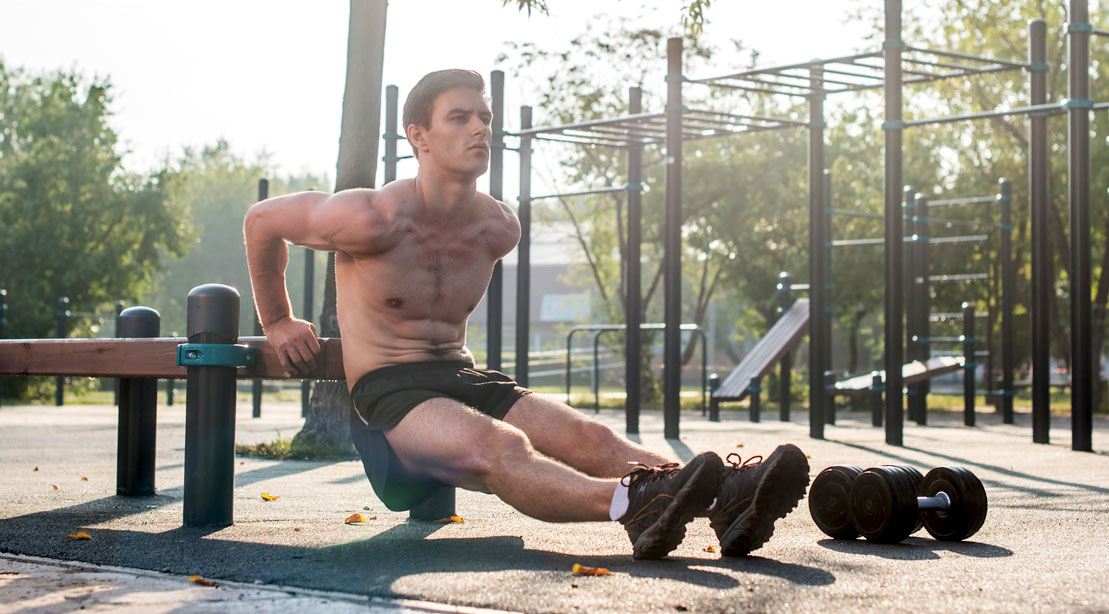Considering the triceps muscle makes up two-thirds of your upper arm mass, it’s no secret that triceps-focused exercises like certain dip variations should dominate arm day. Triceps dips (or bodyweight dips) are a classic, tried-and-tested exercise known for not only adding strength and size to your arms but your chest and shoulders as well.
Without a dumbbell (or a gym) in sight, you can beef up your arms and add upper body strength simply by making dips a consistent part of your exercise program.
Although this move looks easy, (minus the thick chains around the neck of a dip veteran), proper form can take a bit to master and is imperative in avoiding injuries.
When proper form is mastered, dips serve as a much safer alternative to other moves such as the bench press. “Because one moves their body through gravity rather than moving resistance through gravity, dips are actually safer for one’s shoulders over bench pressing,” says Michael Wittig, ISSA CPT, certified nutritionist, and eight-time natural pro champion.
Wittig shares his top tips to help boost your dip experience while keeping bad form and injuries at bay.
Pain With Triceps Dips – Your Body is Telling You Something
If you find yourself in pain when performing triceps dips—not the feel-so-good burn we all love but the type of pain you know you shouldn’t push through—the best thing you can do is stop the exercise immediately. Pain can range from not stretching and warming up properly to a possible injury.
“If any movement causes pain stop that movement,” says Wittig. There are always other exercises that can be done and it’s better to be safe than sorry. “If you have chronic elbow issues [or past injuries] do see a physical therapist and wear compression elbow sleeves,” advises Wittig. This will provide support to the elbow area when exercising.
When performing dips, pain can be felt in your shoulders, chest, elbows, and triceps. If you’ve warmed up correctly, stretched, and still feel pain, contact your doctor for further instruction. This is not the time for the “No pain No Gain” mentality.
If parallel bar dips cause you pain at all or are too difficult to execute in proper form. Wittig recommends that you “consider bench dips and even self-assisted bench dips with your feet on the ground and knees bent at a 90-degree angle.”
Simply put, pain is telling you something—listen by stopping the exercise and visiting your doctor if the pain persists.
Struggling with Dips? Try This
“Dips require a good amount of functional strength to complete enough reps to be beneficial,” says Wittig. He add that there are also a few variations and ways to perform dips. “Some might be confused with the different variations, or just not be strong enough to perform effective repetitions.”
So, when pain isn’t the issue but a struggle to complete the dips with proper form is, there are a few ways to solve this issue.
“If you’re not strong enough [yet] to do bar dips, start with bench dips,” says Wittig.
And if you run into the same situation with bench dips, Wittig encourages you to try the variation mentioned above by placing your legs at a 90° angle with feet on the ground. This will help your upper body slowly and safely build up the strength it needs to keep progressing with different dip variations.
And if you’re struggling with all variations, Wittig recommends staying away from dips entirely and strengthening your triceps by performing Triceps push downs. Eventually, your triceps will gain strength and you’ll be able to move up!
Always talk to your doctor about mobility issues or if you have an injury. Remember to warm up and cool down properly and always listen to your body.
“Because dips are bodyweight movements you can give it another attempt and see if they cause pain,” says Wittig. Keep in mind, Dips are safer than pressing movements. If they hurt to do simply choose another movement that doesn’t cause pain and focus on building strength in those areas.
